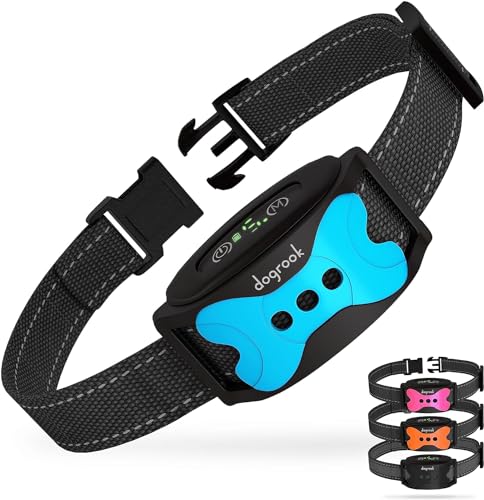Non-stop barking is enough to drive you crazy and create a rift between you and your neighbors. Your dog’s barking may stem from anxiety, a territorial nature, or you may have a breed like a Beagle that simply barks more than others. You love your dog, but, for the sake of everyone’s sanity, you may need help to cut down on the noise, especially if your dog is barking all night long or barking excessively during the day. Dog bark control collars are a simple solution. They can be worn along with your dog’s regular collar and may rely on a spray, sound, vibration, and/or shock to correct barking.
Our vet advisor, Dr. Chyrle Bonk, DVM, researched dozens of bark control collars to find the best. Bark control collars may come with advanced technology that allows you to adjust the bark sensitivity to fit the size and breed of your dog. After taking it all in and weighing the options, she narrowed it down to the SportDOG No Bark SBC-R Waterproof Rechargeable Dog Bark Collar as the best choice to help bring your dog’s barking under control. Read how she chose the top 5.
Even though a bark control collar can help you train your fur baby to stop barking, you should also prepare for the limitations of the bark collar, particularly at night. For example, a lot of collars discourage (or even flat-out prohibit) the use of the collar at night.
Our Vet’s Top 5 Dog Bark Control Collars
Here are the top picks from our veterinarian. Compare the ratings and features of different models.
| Vet’s Picks | Model | Rating | Remote Control | Waterproof? | Modality |
|---|---|---|---|---|---|
| Best Overall | SportDOG No Bark SBC-R Waterproof Rechargeable Dog Bark Collar | Static Shock | |||
| Best Budget Buy | Authen Dog Bark Collar | Static Shock, Vibration, & Sound | |||
| Best Bark Collar with Remote | PetSafe Remote Training Collar | Static Shock, Vibration, & Sound | |||
| Best Ultrasonic | ELOPAW Dog Barking Deterrent Devices | Sound | |||
| Best No Shock | DogRook Rechargeable Dog Bark Collar | Vibration & Sound |
*Ratings are on a scale of 1 to 5 and based on reviews, feedback, and opinions of actual customers
Who Should Buy a Dog Bark Control Collar
- Noise complaints – Dogs who bark while their owners are at work or bark at neighbors and other stimuli face limitations on what an owner can fix. If you’ve received noise complaints, then it’s time to find another solution for the barking.
- You’ve tried everything – If nothing you’ve done seems to have worked, then your stubborn dog may just need more. Dog bark control collars can be effective for even the most persistent of barkers, especially when you’ve run out of other option
- Reward training – Dog bark control collars work best when used along with rewards training, especially in the beginning. For example, put the collar on the lowest setting and wait for your dog to bark.
Who Should Not Buy a Dog Bark Control Collar
- Bigger problems – You might want to try some alternative methods of bark correction before you jump to a dog collar. If your dog has anxiety, a dog anxiety vest may help, or you might want to consider trying a dog calming collar.
- Not your preference – You may choose to not get a bark collar at all. Rather, there are many ultrasonic devices that can help decrease unwanted barking. These devices can be placed in your yard or are hand-held to go with you on walks or to the dog park. They don’t connect to your dog at all, yet can still help control their barking problem. When he does, he’ll get a spray, sound, vibration, or shock and you’ll reward him when he stops barking so that he understands the difference between the reward of silence and the correction of barking.1
Research Tips (From a Veterinarian)
If your dog’s barking is coming between the two of you, or between you and your neighbors, investing in a bark collar may be the best way to go. Troublesome barking is often a behavior issue, but always be sure to check with your veterinarian first to rule out medical conditions that could be causing your dog’s excessive vocalization. If you’re in the market for a dog bark collar, then you’ve probably noticed that it’s not a small niche market. There are many, many collars to choose from. But which one is right for you and your dog? We’re here to help you find out.
- Safety – A dog bark collar has to be safe. You don’t want to put something on your dog’s neck that could potentially hurt them. Safety in dog bark collars means one that is waterproof to help prevent shocking malfunctions from moisture. Unless your dog chooses to bark only on sunny days, a waterproof bark collar will drastically improve his safety.
- Size – Most dog bark collars are sized for small to medium and then medium to large dogs. Check with the manufacturer’s guidelines for your dog’s size and weight. You should also measure your pup’s neck just in front of the shoulders, where a collar would sit, to determine what size you will need. The size of the dog bark collar is important for delivering the proper correction. If a collar is too big, your dog might not feel the vibration or shock when they bark and it may easily slip off. On the other hand, if a bark collar is too small, your pup may become injured from a collar that is too tight or from getting too much of a shock.
- Modality – Dog bark collars may dispense corrections in many different ways. The most standard way is through a static shock. Oftentimes, these collars will have the option of administering a sound or vibration to first warn your dog that a shock is coming if they don’t stop barking. Other dog bark collars use no-shock methods for decreasing barking. Some may spray a whiff of citronella in front of your dog’s nose when they bark. The smell of citronella is irritating to dogs and they may soon learn that barking equals a bad smell. Others may emit an ultrasonic sound that is ear-piercing and irritating. The method that you choose should be based on your dog’s sensitivity to different corrections and your choice of what you feel is best.2
- Adjustability – This goes for the size of the collar and the level of correction. Choosing a collar that is highly adjustable will allow you to change the type and level of correction that your dog needs. You can increase or decrease the intensity based on their responses. A more sensitive dog may need a lower level of correction, while a more stubborn dog will need a little stronger encouragement. This is especially important in the training phase so that the collar can adjust as your pup learns.
- Price – Some bark collars can get downright spendy, while others may seem too inexpensive to be true. You’ll want to find a bark collar that fits your budget, yet is still effective and durable enough to work for your dog.
- Extra features – Some dog bark collars come with a remote so that you can administer a correction when you see fit. Others will work automatically. The type that you choose will depend on when and how often you are needing to decrease your dog’s barking and if you’re around when it’s happening. Another feature that you may want in a dog bark collar is a little flare. You may opt for one that is more discrete or one with a vibrant color that stands out. Whatever your fashionable tastes are, chances are there is a collar for you.
How Much Do They Cost?
Between $50-$100
How much you spend on your dog’s bark control collar will depend on the features (and some on the efficiency). A high-quality, no-bark collar that comes with several modes, a reliable range, and a remote can cost well over $100, while a single-mode collar will probably cost under $50. For most pups, you can find a quality bark control collar that fits your needs priced between $50 and $100.
Our Methodology: Why Trust Pango Pets
When looking at bark collars for dogs, you above all want one that’s safe. That means one where your dog is in no harm of an errant or powerful shock that could potentially hurt them. With this in mind, choosing a bark collar that is waterproof should be a must. After safety, you’ll want to consider efficacy. If a bark collar doesn’t keep your dog from barking, then it simply becomes a fashion accessory. So, choose a dog bark collar that works by checking out consumer reviews and speaking to your veterinarian or professional trainers. – Dr. Chyrle Bonk, DVM
The 5 Best Dog Bark Control Collars: Full Reviews
The SportDOG No Bark SBC-R Waterproof Rechargeable Dog Bark Collar is waterproof up to 10 feet – and that’s probably plenty deep enough for any of your fur babies. It has an automatic safety shut-off so that the stimulation won’t go on endlessly. – And this is a huge relief for excessive barkers – no matter how stubborn he is, he can’t prolong the static shock longer than is safe.
The lithium-ion battery is so high quality that you’ll get roughly 200 hours of use each time you charge it. You’ll want to use this on dogs over 8 pounds, so if you have a toy breed, this isn’t the collar for you and you’ll want to avoid using it for more than 12 hours each day, but when used properly, this collar will very likely control your dog’s bark.
- 10 levels of static stimulation
- Rechargeable battery
- 3 programmable modes
- Only static shock correction
- Requires separate collar for leash
The Authen Dog Bark Collar uses detection technology, coupled with three training modes—sound (beep), vibration, and shock. Within those modes, there are five adjustment levels. You can basically start at the least intrusive form of correction, a low-powered beep, and work your way up to a shock level that puts a stop to the barking. A digital display lets you quickly see your settings without removing the collar.
We particularly like the automatic protection mode in which the collar deactivates when triggered seven times in one minute. That offers you some peace of mind because if your dog gets truly distressed, he won’t be corrected indefinitely.
- Three (3) training modes – sound, vibration, shock
- Long-lasting battery – up to 15 days per charge
- 5 sensitivity settings
- Ultra-sensitive – may respond to other dogs’ barking
- Difficult to program
PetSafe Remote Training Collar is lightweight, so it won’t weigh down your dog’s neck and the three modes of correction will allow you to customize your training as you need. The 15 levels of static stimulation mean you can use this bark control collar for a smaller, more sensitive dog or your big, beefcake dog, too.
While this model isn’t intended for swimming, it’s waterproof enough that if your dog takes an unplanned jump in the lake, it won’t ruin the collar or hurt your dog.
- Expandable for multiple dogs
- 300-yard remote range
- 3-modes of correction
- 40-hour battery life
- Requires hands-on training
The ELOPAW Dog Barking Deterrent Devices isn’t, strictly speaking, a collar, but the ultrasonic sound it emits, combined with the included whistle, and training clicker will allow you to maximize your dog’s training potential with regards to barking. There are three frequencies on the remote to create a more effective training regiment.
The remote control is rechargeable and will display a low power light when your battery life depletes. The battery life is an impressive 2 days when you use it regularly and even longer if you use it only sporadically. – So you’ll charge even less frequently when your dog is better trained. It’s meant for outdoor use and has a range of over 16 feet, making it perfect for yard or park training. – Where your pup may be most tempted to bark.
- Fast charging – less than 2 hours
- Includes wrist strap to wear at all times
- 3 sound frequency options
- Not a collar
- Only sound deterrent
The DogRook Rechargeable Dog Bark Collar leaves shock correction completely out of the equation. Instead, it relies on beeps and vibrations to get your dog’s attention and put a stop to incessant barking. Thick or thin coats aren’t an issue as this model includes two types of vibration contacts to reach through coats of any thickness. Another handy feature of this collar is that it’s fully adjustable, so it should fit any dog regardless of its size.
There are a total of seven correction levels which the collar will automatically work through. If your dog still hasn’t stopped barking after all seven correction levels have been activated, the collar will turn off for one minute to ensure your dog’s safety and wellbeing. But, according to this collar’s glowing reviews, they’ll likely stop before all seven levels have been tried!
- Automatically stimulates in response to barks
- 14-day battery life
- Reflective straps
- Slight delay in correction
- Bulky design
Frequently Asked Questions
What is a dog bark control collar and how does it work?
Will a bark control collar hurt my dog?
How do I get my dog to stop barking when left alone?
What age can a dog wear a bark collar?
- Blackwell EJ, Bolster C, Richards G, Loftus BA, Casey RA. The use of electronic collars for training domestic dogs: estimated prevalence, reasons and risk factors for use, and owner perceived success as compared to other training methods. BMC Vet Res. 2012;8:93. Published 2012 Jun 29. doi:10.1186/1746-6148-8-93
- Sargisson RJ, Butler R, Elliffe D. An evaluation of the aboistop citronella-spray collar as a treatment for barking of domestic dogs. ISRN Vet Sci. 2012;2011:759379. Published 2012 Jan 23. doi:10.5402/2011/759379
- Vieira de Castro AC, Fuchs D, Morello GM, Pastur S, de Sousa L, Olsson IAS. Does training method matter? Evidence for the negative impact of aversive-based methods on companion dog welfare. PLoS One. 2020;15(12):e0225023. Published 2020 Dec 16. doi:10.1371/journal.pone.0225023






















